

Variations of the Runabout Interior
by Jörg Hillebrand and Bernd Schneider
Season 1 Season 2 Season 3 Season 4 Season 5 Season 6 Insurrection Season 7 Summary
The Danube-class runabout first appeared in DS9: "Emissary". Over the years, its cockpit was remodeled several times, most notably between the 4th and the 5th season of DS9. The runabout, including its flight deck set, also appeared in TNG: "Timescape" and in VOY: "Non Sequitur". In addition, the interior was slightly redressed three times to act as Chakotay's ship, as vessels of the Mirror Universe and as the "Insurrection" shuttlecraft.
Our article analyzes the appearances of the runabout cockpit episode by episode. We pinpoint the times when redresses of the set must have taken place or were reverted. While the focus is on the cockpit, we also have a look at the aft section. It was shown prominently only in TNG: "Timescape", but there are also less obvious sightings in DS9.
All variations have in common that they are largely symmetrical, with at most small consoles differing between the port and the starboard side.
The cockpit retains its original look throughout the first season, with only some minor changes until TNG: "Timescape".
Emissary (as Saratoga escape pod)
We can hardly see how far the set extends because of the heavy shaking and because of the many people inside the escape pod. But we can recognize the lateral door and the two pilot seats (pulled closer together) of the familiar runabout set that were used here.

The real runabout interior debuts some time later in "Emissary". We see the lateral doors of the runabout that are opened on the port side at two points in the episode. As we can see, the outer door consists of two sliding wings. While the outer door follows the shape of the hull and is accordingly sloped, the inner door is narrow and possesses an X-shaped structural reinforcement. Looking into the runabout, we can see Dax in front of a yellow illuminated panel, which is embedded in the side wall of the small transporter platform. Everything is symmetrical, so the opposite side wall has the same yellow panel on its outer side. This part of the set will be changed later, hence we call attention to this detail. The inner surfaces of the platform have white illumination, with some sort of grating in front of the lamps. It can be seen only briefly in "Emissary", but it will become clearer in later episodes.

We also get a good impression of the leading end of the cockpit. We can see the windows, the pilot's controls and the rear sides of the chairs, with three tubes between the head rests and the back rests. This will be modified in the course of the series, as well as the consoles in the forward portion of the cockpit. On the very left and very right side beside the chairs we can make out two oblong horizontal black areas. These will change as well. We can still notice in this episode that the two oval side windows are transparent, while they will increasingly often be covered in later appearances of the runabout.
We can see only a bit of the inner side of the inner door, which will be better visible in later episodes. However, the aforementioned X-shaped struts are not yet illuminated here. The red area behind the raised struts seems to have a stripe pattern, which is subject to change just as well.
Finally, we get an impression of the door that leads to the aft section of the runabout. This one is similar to the lateral door and has X-shaped struts as well. It can be found in the middle behind the transporter platform. Behind Dax in her chair, at the port side, we can make out a rectangular black frame on the side wall of the transporter console. This space is still empty. Later in the series a deepening to store phasers and ultimately a small replicator can be found in this place.
Past Prologue
When the runabout appears for the second time, some small changes have already taken place. In this episode there are two different runabouts : O'Brien and Sisko are on the Ganges, Kira and Tahna Los on the Yangtzee Kiang. The only small difference between the interiors of the two vessels can be found in the lighting of the side doors. On the Yangtzee Kiang, the X-shaped reinforcements are not lighted, as its was the case already in "Emissary". On the Ganges the struts are illuminated for the first time. Furthermore, between the two big cockpit windows there is a hidden console that can be moved up. A red button serves to launch the bomb. The console, however, was visible already in "Emissary".

A noticeable difference can be found behind the transporter console. While there used to be a door in "Emissary", both ships in "Past Prologue" have a pentagonal cavity in this place, holding a number of small consoles and printed circuit-like power conduits. Tahna Los uses this access point to install his bomb. Actually, on the two shuttles there are no doors at all that would allow to enter the aft section, not even on either side of the new console! On both runabouts we can also see two new deepenings on either front side of the transporter side wall, holding phasers. In "Emissary" there was just a frame around this area. We can have a good look at the transporter platform itself, including its white illumination on the inside.
The next appearance of the runabout set is in "Babel". Once again we can see the pentagonal cavity in the rear wall and the small phaser shelves, and no door leading aft. On the side wall it can be noticed that the window is still open and that the oblong black bar is dark. But that is already all we can see of the flight deck.
This is an episode in which we can never see the outside of the runabout but only its full-scale interior set. First of all we get a good impression of the interface that is located next to the entrance on the rear wall of the cockpit. It is the same on port and on starboard. It is a standard LCARS interface.

For the first time we can see how someone opens the floor hatch that that is located in front of the transporter platform. The hatch is pentagonal. It appears to be quite heavy and is affixed to the floor with a hinge joint. It flips open rearward. Furthermore, we can see the illuminated X-struts in the side doors as well as the white light inside the transporter platform in this episode. In this episode it does not become evident what is located behind the transporter platform. The phaser cavities are still there, but without the phasers.
When Sisko exits from the runabout we can see across the otherwise dark cockpit that the "X" on the door on the opposite side is accordingly illuminated too. Earlier in the episode, we can watch people that walk directly from the station's hatch into the shuttle. Hence, the complete flight deck set (and not just a door) must have been docked to the docking hatch set.
The Passenger
In "The Passenger" the cockpit shows up just briefly. But we recognize that the sliding door at the rear end is there again. It is the same door that was already present in "Emissary". The phaser storage is empty, the side door has illuminated struts and the dark area on the side of the front consoles is still without light. Also, the window is still uncovered.

Here we can see that the pentagonal cavity at the rear end is back again. The phaser storage is empty, the windows are unbarred and the X-struts are lighted. The yellow illumination of the transporter side walls is still the same too.

However, we are shown for the first time the function of the lateral black bars. They serve to indicate red alert, in a rather obtrusive fashion.
Battle Lines
Nothing was changed about the rear end of the cockpit since the last appearance. We can see the pentagonal cavity again.

More interestingly, we get to see the outer hull of the crashed shuttle (which normally appears in the form of a miniature only). Below the side window there is an emergency exit hatch that Bashir blows off. Furthermore, the warp nacelle that was ripped off is totally wrong and was taken from a Type-6 shuttlecraft.
Doug Drexler: "Yeah, I remember it clearly. We all knew it was wrong. We pointed it out, but the feeling was that it was general texture, and the camera would never see it. Ha,ha!"
The Storyteller
We are shown only a small portion of the cockpit in "The Storyteller". The side door is once again illuminated and the windows are open. We suspect that there is a pentagonal console behind the transporter. Most notably we can recognize that the oblong "red alert" console is not black anymore. It now holds a couple of small LCARS panels, probably to make it look less boring when there is no red alert.

We can see the new lateral LCARS consoles on the port side somewhat better in this episode, as well as the transporter platform and the cavity behind it. Otherwise there is nothing interesting to note.
Dramatis Personae
There is nothing new in this episode, other than that we can see the new LCARS console on the opposite starboard side too. "Dramatis Personae" is the last appearance of the runabout interior in DS9's first season.
TNG: Timescape
Chronologically, the next time we see it is in TNG: "Timescape".
The features that have remained the same since the last appearance include the formerly black bar with the new LCARS interface on both sides, the lighting of the transporter platform, the open windows and the illumination of the X-struts. The phaser storage is empty, but the simple deepening is given more contrast using the famous black tape stripes. It is the first time since "Emissary" that we can have a good look at the forward portion of the cockpit from behind. It seems unchanged, including the red button console from "Past Prologue".

The flight deck now has a central door in its rear portion through which the crew enter the aft section of the runabout. It is overall identical to the one see in "Emissary" and "The Passenger", but does not have the lateral illumination of the preceding episodes. We can see this part of the set with an opened and with a closed door. It is possible to walk to the left and to the right after passing the door; the straight direction is obstructed by a wall. Quite obviously there is no long corridor, as this would have required to attach the new aft section directly to the cockpit set. The new wall appears to be the same that used to be in place of the door in some episodes, but now moved about half a meter rearward.
The door in the aft section of the runabout is identical, only flanked by two fluorescent tubes. Behind the opened door we can see the probably same pentagonal cavity that can be passed by on the left or on the right side, which of course is meant to be on the other side now, facing aft.
As already mentioned, in "Timescape" we see the aft section of the runabout for the first time. As we exit through the rear door of the cockpit, there are sleep compartments on either side. These were later re-used for the interior of the Defiant. Upon entering the aft compartment, there is a replicator on the right side and a computer console on the left side. There are five upright windows at the aft end, which correspond with those on the runabout model. In the middle of the room there is an oblong table and four chairs, the same that will later appear in Voyager's conference room.

Aside from the new compartment, the most important change to the flight deck set is that the former rear wall of the set with the cavity can now be found behind the rear door, which will be like this on the DS9 runabouts as well.
In season 2 the cockpit retains the recessed aft wall behind the door as it appeared in TNG: "Timescape" (at least in most of the episodes).
The Homecoming
The cockpit has its first appearance in this season in "The Homecoming". The first thing to notice is that the small phaser shelf has been replaced by a black console. The lateral door, including the light, is still the same. We can also notice that the rear area of the command section is like in "Timescape", with the pentagonal deepening about half a meter behind the rear door. The large viewscreen on the side of the cockpit has been slightly modified. If we compare its first appearance in season 2 with the last one in season 1, we can see the smaller horizontal field with the white border has been moved from the upper to the lower edge of the interface. The yellow side wall of the platform and the screen beside the door are still the same.

In "The Siege" we only see the docking hatch of the runabout. Unlike in "Emissary" and in "Q-less", not the entire flight deck set was placed beside the station docking set, but just its entrance hatch, with the already well-known deepened wall obstructing the view, although it should not be behind the runabout's entrance. This will be done in several other episodes too.

Cardassians
This episode shows the cockpit set from an unusual perspective, as we can look inside through the open lateral window. There is one recognizable change to the set. So far the triangular boxes above the corner monitors on either side of the pilots' seats were horizontal on the underside. The built-in light aimed straight down. Now the boxes are sloped, with the lights pointing inward.
In "Melora" we can have a good look from the aft at the forward end of the cockpit again. The only change seems to be an addition to the lower console between the two seats. We can see the interface with the movable cover and the red button from "Past Prologue". Beneath the pentagonal console in the familiar wall (now behind the rear door) we can see a new illuminated rectangular area. The side walls of the cockpit are unchanged and the windows are open.

Second Sight (as USS Prometheus interior)
In this episode, the aft compartment set is clearly visible for a second time besides TNG: "Timescape". It was rearranged and now serves as two or three different rooms on the USS Prometheus. The wall with the door leading to the cockpit (now completely red) remains the same as in the TNG episode. The bunk beds on either side and the archway in front of them were removed. A door or gateway was installed on the port side, which is recessed relative to the former bunk beds and makes the set appear somewhat more spacious and less one-dimensional. In the following, "port"/"starboard" and "fore"/"aft" refer to the orientation on the runabout.
We don't see the aft window in the episode, which would have given away that it is the runabout set. In fact, a new wall was inserted instead, including two doors with rounded edges similar to the original one that leads to the front. The difference is that the new doors don't have a double frame. This is an important detail to identify which part of the set we are looking at. There really are two new doors, which we can see only briefly in the third scene the set appears in.
The port and starboard walls with the characteristic zigzag cross-section are still the same as in "Timescape". We only see the windows on the starboard side, which complies with the idea that the set is aboard a starship, as opposed to the narrow runabout. In fact, the starboard side is all windows now, whereas the port side of the set consists of just solid walls with the zigzag shape and a console. This is the same wall portion that was previously located on the starboard side in "Timescape".
The room appears four times in the episode, first as a dining room with a table, then as Sikso's guest quarters, then as Nidell's living room with a couch and a table and finally as some unspecified room. We assume the set was not rebuilt but remained the same throughout the episode, except for slightly rearranged furniture and decoration.
The first time, during the dinner, we can mainly see the starboard side of the set, which is all windows. The solid port side is hardly visible at all, except for the new gateway. We don't see how the guests enter the room, but it is implied that it is through the "old" central door. Seyetik then leaves the set through the "new" aft door on the starboard side when he looks after his wife Nidell. We can see that the new portion is also where the bunk beds are located now, behind the door on both the port and the starboard side. Most likely this is the bedroom of her quarters (although Nidell is said to have prepared the meal).

The second appearance is only brief. Sisko finds Fenna in his quarters when he enters through the "old" door. Once again, we can see the windows on the starboard side.
Right after that, the set appears for the third time, as Nidell's room. The difference is that now the characters (Sisko, Dax, Fenna) use the "new" door on the port side to enter, passing by bunk beds that are located here as well. It almost looks like it is an entirely different set, but we actually just see the other side that the two previous scenes concealed from us. As already mentioned, the solid wall is exactly the same that was also used in "Timescape", but on the other side of the set. Later in this scene, we can also see the windows on the opposite (starboard) side, as well as both new aft doors. Actually, the room could be the very same that earlier appeared as the dining room; even the table is the same. But it would not make much sense for Sisko and Dax to enter through a door that most likely leads to another private room.

When Sisko and Fenna meet for the last time, they are sitting in front of the starboard windows. This may be Sisko's guest quarters yet again. Since the scene consists only of close shots, we can't make out any decoration or furniture that would more clearly establish the location.
The Alternate
Nothing has changed in this episode. We can clearly see the lateral door, still with red stripes and with the illumination of the "X".
Armageddon Game
This is the first time that we can make out a small control interface on the forward starboard side of the transporter console. Otherwise the cockpit remains unchanged. The transporter console is still white on the inside, with a grille in front of the fluorescent tubes. Furthermore, we can see that the door to the aft compartment is shut again, not revealing the wall that should be in the corridor behind it.

The perhaps most significant change, however, is that the windows are barred for the first time. The main reason is that it saves costs in the post production if no stars have to be inserted. The window is covered by simple beige panels of the same color as the walls. The lateral interfaces in the forward portion of the cockpit are unchanged. The X-struts in the door are lighted. The lateral black panels are not permanently illuminated, however.
In "Paradise", the windows are covered with the beige panels too. The replicator, however, has been replaced by a simple flat interface. The rear door is open, with the wall behind it.

In this episode the windows are open again. Otherwise there is nothing special.
Playing God
We can clearly see the front portion of the cockpit, where nothing has changed since "Melora". The windows are barred again with the beige covers. The replicator is there again, on both sides, as it may have been the case already in "Whispers". On the other hand, the two small interfaces at the front side of the transporter are gone. The rear door is closed, the side doors are still the same.

The Maquis, Part I
The doors are open again, revealing the wall with the cavity.
The Maquis, Part II
We can see different runabouts in this episode with slightly different interior arrangements. As we are shown only the lateral front sections of the runabouts, the only visible change is to the windows, however. At the beginning of the episode Sisko, Dukat and O'Brien are flying the Mekong. The windows are open, allowing to look outside.

Later on, Sisko and Dukat take the Rio Grande, whose windows are open as well. Kira and Dax, on the other hand, are on the Orinoco, and Bashir and O'Brien on the Mekong. On the two latter vessels the windows are covered with the beige panel.
This is the first episode to feature the new, more sophisticated looking window cover that doesn't let the windows look like painted over. It appears to consist of two parts and has a reddish basic color (maybe the same as in the doors) with beige borders. At the rear end we can recognize the pentagonal wall console again, but with a significant change. The console is integrated into the rear wall again, hence no access to the aft section is possible. In this episode we can clearly the ceiling of the set as well as the front portion. There are no other changes.

In this episode the wall is moved back again, so that Keiko can stay there and use a replicator that was placed there. The windows are open. The transporter platform is still the same.

The Jem'Hadar
The last time in the second season that we see the runabout is in "The Jem'Hadar".
The aft end is unchanged since "Tribunal". This is another episode with more than one runabout, which differ in their windows but also in the door to the aft section. Sisko, Jake and O'Brien take the Rio Grande to the planet. The door is open and we see the familiar pentagonal console. The windows are open. On the Orinoco with Bashir and Kira the windows are closed with the new cover and the rear door is open. On the Mekong, finally, with Dax and Odo the windows are closed as is the rear door.

The Rio Grande reveals a modification to the lower console between the pilots' seats. Here we can see a terminal holding a couple of isolinear chips. We can see a floor hatch again, but with a different shape than in "Q-less".
Also in this episode, we can see how Jake and Nog enter and exit from the runabout. It seems that, as already in "The Siege", the runabout set was not combined with the station's docking set, which facilitates the production of the episode.
After an appearance in VOY: "Caretaker" the runabout flight deck was significantly remodeled for the first time, prior to the first appearance in the third season of DS9. Many of the consoles were replaced with new, more sophisticated looking ones. The basic floorplan of the set remained the same, but there are a couple of changes that will gradually become apparent in the episodes of season 3.
VOY: Caretaker (as Maquis raider)
The cockpit set was modified to act as the bridge of Chakotay's Maquis raider. The LCARS displays were swapped with 23rd century-style computer controls and supplemented with occasional coffin-shaped structures to separate two consoles. The doors and the wall at the cockpit rear end were given a new, partially ribbed surface, encompassing the transporter platform. In addition, the characteristic oval port and starboard windows were closed and were covered with another computer display. Later in the episode, however, when Chakotay is on the raider again and prepares to ram the Kazon mothership, the windows are open again and we can see the stars.

Overall, the changes look extensive, but they mostly consisted of add-ons that could probably be removed rather easily. Only the front consoles retained their look when the set was turned into the runabout cockpit again.
Heart of Stone
The first time that we see the new runabout interior is in "Heart of Stone". The consoles in the front portion are all renewed with new 24th century LCARS displays, the structure of the section is the new one already seen in "Caretaker". The initially unlighted long black box on either side wall was removed altogether. The new console in its place protrudes less into the cockpit area. The corner above that console with the monitor was replaced with a still larger screen, but one that follows the hull shape and hence appears less boxy. There is some sort of rubber protection strip around the consoles.

We can also notice that the two side doors have been changed. The filling between the beige struts is not striped anymore, but solid red. In addition, two horizontal lamps were installed, which can be seen better in later episodes. The side windows appear to be unchanged. In "Heart of Stone" the rear door is closed. The transporter platform seems to be still unchanged.
We get a better impression of the new interior in this episode. The first thing to notice is the modified inner side wall of the transporter platform, which consists of vertical blue lights strips now. We can see how people are rushing towards the shuttle. The door is opened, and at some distance behind it we can (barely) recognize the familiar pentagonal console again.

We can also have a look at the console area of the runabout. The most noticeable change is that the chairs were modified. The tubes and other attachments were removed, making the seats overall more simplistic. This may have been already the case in "Heart of Stone". In front of O'Brien we can see the new consoles.
The new horizontal lamps can be found above the side doors. The small replicator in the front wall of the transporter platform is still there. In addition, there are two silver handles on either side of the replicator, which are shown more clearly in later episodes.
Through the Looking Glass (as Terran raider)
For this episode the cockpit set was modified for the second time to act as a vessel of a different type. It is the Terran rebel raider, actually the same design as the Bajoran assault vessel. Black stripes were added all over the place, even on the lamp above the side window. The consoles were replaced with a 23rd century design. The window was covered by a new console, and the transporter platform is now hidden behind a console. The ceiling illumination is red here. Interestingly, this is the first time that we see the new outer wall of the transporter platform. The formerly yellow pane was replaced with a greenish blue one that consists of stripes and looks just like the other (inner) wall. The phaser holder is there again, the console in that place is gone. In the place of the replicator we can see a new console, including the Terran emblem.

Improbable Cause
The runabout set had to be reverted to its former state for this episode. We can notice, however, that the two screens at the aft wall of the cockpit were slightly modified. The red door to the aft compartment is closed. The windows are closed as well. We can clearly see the handles on the wall of the transporter platform. The replicator is there again, and is used in the episode. The modified pattern on the inner walls of the platform is visible as well. The side doors are still the same since "Heart of Stone".

The Die is Cast
The only change in this episodes (showing the very same shuttle on the way back from the very same mission) is that the windows are open now.
We can see Nog and Jake in a simulation of the runabout cockpit in Quark's holosuite. The runabout is the same as before. The aft door seems to be open, and we can have a good look at the new consoles with the padded edges.

VOY: Non Sequitur (as Yellowstone class)
The runabout cockpit takes a detour to VOY: "Non Sequitur" before it appears in DS9's season 4. The Yellowstone-class cockpit is the same as that of the latest Danube class from DS9. The windows as well as the rear door appear to be closed. The lighting of the side doors is the same as usual. The transport platform including the handles are the same as well.
Not much happened with the cockpit prior to season 4.
The Visitor
We witness how Jake leaves the station on a runabout. We don't see the cockpit but only Jake looking at the station out of a window. This must be the aft window row in the aft compartment of the vessel.

Hippocratic Oath

As already in "Q-less", O'Brien is working on a hatch in the floor. Its position is still the same, but instead of flipping it open this hatch can be completely removed. The circuitry underneath the hatch has changed as well.
Indiscretion
The next appearance of the cockpit is in "Indiscretion". Here the window is covered again, with the same sheet as in all recent episodes. The difference is that this time the cover is flush with the inner surface of the cockpit and not deepened. Also the recessed part of the cover is now beige like the frame. We can see behind Kira that the door is closed.

Sword of Kahless
The old recessed window cover is back in this episode. The door is initially closed, and when it opens we can recognize the pentagonal console in the wall behind it. Otherwise there is nothing different here.
Our Man Bashir
In this episode nothing has changed either. The aft door is closed. The "columns" that are visible outside right behind the windows in flight direction (port as well as starboard), however, are strange, as nothing like this can possibly be visible outside the vessel. Could it be that this is a part of the set that normally shouldn't be visible?

Sons of Mogh
Here we can see again what the unobstructed view outside the windows should be like. The door is closed. The actual set is unchanged.
The windows and the door are closed in this episode. When Kira and O'Brien leave the shuttle, we can see once more how the wall with the pentagonal console serves to obstruct the view, although it should not be where we see it.

Shattered Mirror (as Peregrine class)
Once again the whole set was redressed for a totally different vessel, this time for a Peregrine-class fighter. The set is overall similar to the one from "Through the Looking Glass", including the excessive black lining and the 23rd century-style consoles. The ceiling lamps, however, are not red here but the "X" on the side doors is lighted red. Once again the windows were covered, with what looks like molten consoles.
The Quickening
The last time that the cockpit appears in its 4th season runabout version is in "The Quickening". The windows are covered, the door is closed. Otherwise everything is as it should be: replicators, LCARS interfaces, handles, illuminated X-struts and the pattern on the transporter platform.

For season 5 the cockpit was once again extensively rebuilt, for the first time since season 3. This time especially the rear portion of the set was modified, whereas the area around the seats and consoles remained untouched.
The first time that these changes appear is in DS9: "The Ship", but the scenes are so blurry that we don't see too much of them.
Nor the Battle to the Strong
This is the first time that we can clearly see the modifications.
The transporter platform was moved from the front section of the cockpit to the area behind the rear door. The door was widened and is (at least in this episode) permanently open. The two monitors that are located on either side of the door in the rear wall were modified as well. The right one now displays a view of the runabout, while the left one has a new LCARS interface. In the former place of the transporter console there is a new separate console, that allows to pass on the left or the right (easier than with the transporter in that place). On either side of the transporter platform there are narrow doors that allow access to the aft compartment. The transporter platform is open only on the front side, the rear panel is illuminated. The LCARS panels on the transporter and the two replicators still exist, only the handles were removed. From now, the cockpit windows are mostly barred.

Without further modifications we can see this new cockpit in "The Assignment", "Let He Who Is Without Sin", "Things Past", "The Ascent", "The Darkness and the Light", "In Purgatory's Shadow", "By Inferno's Light", "Blaze of Glory" and "Empok Nor". In all these episodes the windows are covered and the door is open.
Something of interest in this episode is the new rectangular hatch in the cockpit floor behind which the Orion Syndicate's bomb is hidden.

The Darkness and the Light
We can see for the first time that on the side walls behind the new big opening at the aft end, there are large LCARS panels. These look different in almost each episode.
In Purgatory's Shadow
There is a problem with the way that Garak enters the ship. We can see how he is standing in front of the docking hatch, how the outer door of the runabout slides to the side and reveals the usual pentagonal console that shouldn't be there. Garak steps in, but from the inside we can see him come in through one of the doors beside the transporter platform, not through the side door behind the window. There is no other door on that side of the hull. The goof may have been more or less deliberate, as it was required to let Garak enter the cockpit slowly enough to notice only after a few seconds that someone is already sitting there.

Blaze of Glory
We see how Sisko is working in a Jefferies tube in the aft section of the ship. We have to wonder where the space is for a full-scale Jefferies tube though. When the door opens there is the usual pentagonal console in the background, simply to obstruct the view.

Here the crew enters the normal way through the side door again. In the background the docking tube is visible. The episode also shows the area between the rear door and the transporter.

Nothing exciting happens with the cockpit in season 6. The windows are always barred. The big red door is mostly open, except for "Valiant".
One Little Ship
This is the first time that we can see the cover on the runabout's windshield.

Change of Heart
This is the first episode where we can see how the big door to the aft section slides open.

There is also a blooper in this episode, albeit not a very obvious one. When Jake's and Nog's runabout is being pursued by the Jem'Hadar, the two are shown head on, from the area of the windshield. The window pane including the central strut, which is normally located just forward of the trapezoid panel, has been removed for this take. Otherwise the latter would have obstructed the view. We can still see the contours of the junction with makeshift paint.
Star Trek: Insurrection
Star trek: insurrection (as enterprise-e shuttle).
The summer break between the 6th and the 7th season gave the set builders the opportunity to redress the cockpit rather extensively for the streamlined Enterprise-E shuttle in "Star Trek Insurrection".
The window frames were removed and replaced with different ones matching the outside view of the shuttle. The two side windows were covered with consoles. The wall is continuous where the big door opening used to be on the runabout. A transporter platform is now located here. There are still LCARS displays on the left and on the right, but with different graphics. The consoles underneath the front windows are similar as those of the runabout though. Overall, the new cockpit was given much darker, earthy colors. The chairs are still the same.

For this season the cockpit was reconstructed and repainted to its previous appearance. The front end is the same again as already in season 5. The windows are always closed in season 7. There are once again different LCARS panels on the two side walls behind the big central door.

Treachery, Faith and the Great River
Here we can see for the second time (since "Valiant") how the large door at the rear end opens and closes.
A ventilation opening was added to the central wall to allow Laas to flow into the ship. This opening, however, hardly makes sense in this place, as the wall is very thin here and the retracted door is right behind the grille.

Prodigal Daughter
In this episode the pentagonal console makes another appearance behind the runabout's entrance hatch.

What You Leave Behind
This is the last appearance of the runabout, and we can also see the out of place pentagonal wall behind the entrance hatch for a last time.
The following images illustrate the basic configuration of the runabout before and since season 5, when the transporter was moved behind the rear door.
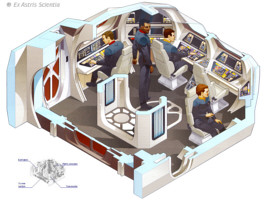
Here is an annotated list of all appearances of the runabout set:
Re-Used Shuttle Interiors - runabout interiors, other shuttle cockpits
Redresses of the Type-9 Shuttle Cockpit - its various re-uses for Starfleet and alien shuttles
Redresses of TNG's Alien Shuttle Cockpit - history of the cockpit set that appeared in many TNG episodes
Galleries - Starfleet Bridge Illustrations
Thanks to Alex, who spotted the goof in "Valiant", and to DataCable, who found the new light arrangement in "Cardassians". Thanks also to Svetz Falhain for the hint about the appearance of the aft section in "Second Sight" and to Richard Compton for pointing out the use of the set for the Saratoga escape pod.

https://www.ex-astris-scientia.org/inconsistencies/runabout_interior.htm
Last modified: 28 Jan 2024

© Ex Astris Scientia 1998-2024, Legal Terms
This website is not endorsed, sponsored or affiliated with CBS Studios Inc. or the Star Trek franchise.
Fleet Yards

Gilso's Star Trek Schematics

Designing the Defiant

The script of Star Trek: Deep Space Nine ’s Season 3 episode “The Search” called for a new class of warship, one it described as “a little clunky.” This starship “was built primarily for battle,” it said, “not exploration or science.”
The reason for introducing the ship was that Executive Producer Ira Steven Behr and his writers felt that mere runabouts couldn’t defend Deep Space Nine against the Dominion, who had shown themselves capable of destroying a Galaxy -class starship in the Season 2 finale, “The Jem’Hadar”.
“We had all these plans for this Dominion,” said Behr in an interview for Star Trek: Deep Space Nine ’s Season 3 DVD, “and what were we going to go after them with? Shuttlecrafts?” He added, “You know, it just seemed ridiculous. So we needed a ship.”
Beefed-up runabout
Yet it was the runabout concept artist Jim Martin initially “beefed up.”
“I started with the cockpit windows,” he recalled in an interview with Star Trek: The Magazine , “and worked my way out, adding things on top of the runabout, making it look like they were adding systems and weapons to an existing ship.”

The producers didn’t like it. “After the idea for the runabout was shot down, it was replaced with the writers’ idea that it was going to be a full-fledged fighting starship called the USS Valiant .” But Herman Zimmerman, Star Trek ’s veteran production designer, cautioned Martin it should still look like something that hadn’t been seen on the show before.
The writers requested a small starship, which was designed by the Federation to battle the Borg. I drew some familiar looking Starfleet designs, but also included a drawing of a small, compact ship that I had done for an entirely different episode of DS9. This is the direction that they chose, I think it was because it was so unique.
The design was inspired by a Maquis fighter Martin had previously designed for Deep Space Nine and it bears resemblance to a small Cardassian vessel, later known as the Hideki class, that Rick Sternbach designed for the Season 2 episode “Profit and Loss.”

Unique design
Zimmerman’s request for something unique was certainly met: Defiant was the first Starfleet ship without external warp nacelles.
Martin didn’t quite recognize the impact it would have:
When you’re in the Art Department and you’re doing the job from episode to episode, you don’t really think, “Boy, this is really going to revolutionize Federation design.” You’re getting a design out of the way. It’s only after the fact that you think, “Wow, that was a different idea.” I’m glad we took the chance to take a little bit of a departure.
The name Valiant was dropped in favor of Defiant out of fear that it might conflict with Star Trek: Voyager and its titular starship.

The design was refined further when Tony Meininger was tasked with building the model. He didn’t think Martin’s drawings made the ship look quite fast enough, so Meininger, a car enthusiast, drew from Ferrari posters to “streamline” it, making the USS Defiant look sleeker and more compact.
The ship was “digitalized” for Star Trek: First Contact by Vision Art and rendered by Industrial Light and Magic. For Deep Space Nine , a digital model was created by Digital Muse.
Adrift, but salvageable
The ship was nearly destroyed in First Contact . Indeed, early drafts of the script suggested it was meant to be lost.

In a DVD commentary for the film, Producer Ronald D. Moore explained that Behr had seen the script and objected to the needless destruction of the ship in a story that didn’t even involve Deep Space Nine . The Defiant was allowed to survive the battle — “adrift, but salvageable” — and hardly a mention of its participation in the battle with the Borg Cube was made in Star Trek: Deep Space Nine .
The Defiant was ultimately destroyed in the Season 7 episode “The Changing Face of Evil”, but a replacement showed up just five episodes later.
A brilliantly designed ship.
Submit comments by email .
Runabouts occupy a range of usefulness between a shuttle and a small starship. Generally modular in nature, they are built with the "go anywhere, do anything" school of thought, which makes them useful for low-intensity missions independent of their base or mothership. With greater defenses, range, and accommodations, these craft are suited for missions of over a week and can be outfitted for even longer missions when necessary. They are more commonly found aboard starbases, though most starships can handle at least one in their hangers. These are the most capable auxiliary craft in Starfleet.
- 1 Danube -class runabout
- 2 Arrow -class runabout
- 3 Volga -class runabout
- 4 Orion -class runabout
- 5 Delta -class runabout
- 6 New Atlantic -class runabout
- 7 Executive type runabout
Danube -class runabout
The Danube -class runabout was designed in the mid-2360s to serve as a standardized utility vehicle across the Federation , capable of low-intensity tasks across multiple mission parameters, ranging from cargo transport to passenger service to scientific missions to medevac. With a standardized cockpit module and warp sled, multiple modules could be used with this class of vessel to do things that simple shuttles could not and that a full starship would be a waste for. This class was intended mainly for starbases though was also assigned to large starships. It remains one of the most common medium-sized craft in service, over thirty years later, because of its utility and survivability.
This class of runabout has a cockpit module that has a standard exterior with two interior variations: the primary differences being that the later module has a free-standing console in the center of the cockpit, while the transporter has been pushed back to its own compartment, rather than being in the cockpit itself. Both modules continue to be produced, though the variation with the free-standing console is more common now. Aft of this, modules can be installed in many different configurations, the most common being a corridor module with four quarter-sized modules connected to it. A single large module, two half modules, and many other combinations can also be achieved. These modules are quick to build and install and have a wide variety of purposes. There is a standardized aft module with a crew rest area, lounge, and replicator, but this can also be customized or omitted when there is a large module that takes up the entirety of the craft aft of the cockpit. Additional roll-bar modules such as torpedo launchers or sensor arrays can be added above the vessel as well.
Armaments are comprehensive, with all-around coverage of phaser arrays and two microtorpedo launchers, and its tactical utility can be increased further with specialized modules that can make it into a formidable patrol vessel.

Arrow -class runabout
Developed in the late 2380s, the Arrow class runabout is a much larger craft than the Danube class runabout, at around twice its length. It is intended for longer duration missions and can support larger crews. Unlike its smaller cousin, it is less modular; interior spaces can be reconfigured for mission needs, but it is more complicated than simply swapping different modules, so typically these vessels remain in a single configuration for extended periods of time.
These vessels are sleek and angular, with large wings to increase their performance in atmospheric flight. They have several phaser arrays and torpedo launchers, which make them capable patrol ships. The forward cockpit can seat up to nine and there are additional stations and a four-place transporter aft. A crew rest area is located amidships with views out into space, along with compartments that can be configured as bunk rooms or labs. Further aft are other mission configurable spaces and a relatively large cargo hold. Access to the lower deck is provided from ladders amidships as well as ramps leading down from the cockpit's side exits, and this level contains two hatches compatible with most standard docking ports, as well as additional equipment storage. Primary egress and ingress is provided by a forward ramp that lowers from the floor of the sub level.
Configurations of this vessel include as a patrol craft, as a scout, as a small research vessel, as a passenger transport, and as a general utility vessel. They are too large to be used aboard most starships, but they are common at starbases.
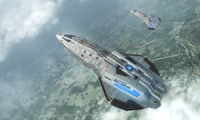
Volga -class runabout
The Volga represents the Federation's best effort at a compromise between the need to provide smaller Starfleet vessels with long-legged runabout support and the limited hangar space which is usually available on such ships. Smaller than many contemporary shuttle designs, the Volga is rated as a runabout due to the remarkable range enabled by her highly efficient warp core and the extensive instrumentation and advanced tactical systems adapted from the Delta Flyer project. While the development of more powerful and capable runabouts has been a boon to Starfleet since their inception in the early 2370's, the large size and extensive maintenance requirements of these high-performance craft have been a persistent barrier to their deployment on small starships or Starfleet installations which would benefit the most strongly from their enhanced capabilities.
The Volga has a relatively large forward cockpit which is similar to a type-11 shuttle , but the forward stations are split. Aft of the cockpit is a two person transporter as well as a crew rest area, followed by a small cargo bay. It is substantially faster than shuttles and has deployable airfoils for enhanced atmospheric performance. These airfoils also have wingtip phaser arrays. This craft operates with a standard crew of six, but can also be configured to carry up to twenty people on shorter missions. It is less modular than other runabouts, as there is much less space available for specialized equipment, but it makes a very capable general support craft for small starships. Entry is provided primarily by a large aft ramp, but there is also a docking port on the top of the craft. Unlike most Federation small craft, the Volga is equipped with landing struts that deploy to allow for appropriate ground clearance when the vessel is on the surface.
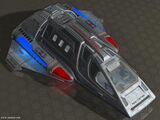
Orion -class runabout
Designed originally as a faster, more heavily-armed version of the Danube class runabout (a project that would eventually become the Arrow class runabout), the Orion class project was tailored in the last few months before the Dominion War broke out as a high-speed scout vessel, that vastly outperformed all other small vessels, with an astonishingly-fast warp drive that could top Warp 8 on a regular basis. This vessel was designed to be able to linger in or near enemy space with a small profile and powerful sensor arrays that would be equally as useful for peacetime applications. During its wartime service, it proved especially popular with Starfleet Intelligence, for its ability to get in and out quickly before it could be detected, even without a cloaking device. However, because of this advanced warp drive system, it's systems are consider rather high maintenance and it spends a lot of its life in the hanger. Post-war, this craft has seen service on frontline outposts and starships, enabling explorers to increase their effective range and dramatically improving the effectiveness of patrol vessels.
This vessel is built for the primary mission of scouting, but it can also be used as a high-speed courier for small, sensitive packages or important individuals. It has a normal crew of three, a pilot, a commanding officer, and a mission specialist, but can accommodate a fourth person if necessary. The Orion can support missions of up to several weeks, with two crew cabins and a mess area, along with a transporter, replicator, and medical supplies. Most of these vessels have been refit with EMH programs as their duties call for them to frequently be out of contact with Starfleet. Access to the vessel is provided by dorsal and ventral hatches, along with a larger hatch on the stern of the craft that is also equipped with an airlock for EVA situations. Tactical systems are relatively light, as the vessel is designed to flee rather than fight, but it does have a forward phaser bank and two aft banks.
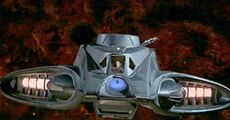
Delta -class runabout
The Delta class was created from the efforts of the crew of the USS Voyager to establish a new, formidable and multi-purpose small craft that could perform tasks well above and beyond that of the Intrepid class' standard Type 9 shuttlecraft . The Type 9 shuttles suffered from being cramped, short-ranged and limited in capabilities, which hampered Voyager' s efforts to get home from their estimated 70+ year journey through the Delta Quadrant .
The first of the class, the Delta Flyer, was originally constructed by Lieutenant Commander Tuvok, Lieutenant Tom Paris, Lieutenant B'Elanna Torres, Ensign Harry Kim and Seven of Nine. The Delta Flyer's original mission and reason for construction was to retrieve a multispatial probe from a gas giant, and therefore was outfitted with tetraburnium hull plating which would help it survive the massive amounts of pressure. However, while constructing the Delta Flyer it was decided that the crew would outfit the ship with all the latest and most potent technologies in order to make it a multipurpose vessel to suit all their needs. Eventually Borg-enhanced regenerative shielding, bio-neural gel pack circuitry, retractable warp nacelles, more "pilot-friendly" controls for better control handling, upgraded warp systems and a phaser array system were all installed during the construction of the vessel.
When Voyager returned to the Alpha Quadrant, the Starfleet Corps of Engineers immediately began to implement the design with a few upgrades to the Starfleet systems that Voyager didn't have during the ship's construction. Although somewhat resource-intensive for a runabout, it paid itself off two-fold in its usefulness and abilities. These vessels are highly advanced but they take up a lot of hanger space. Like the more ubiquitous Volga class, they're less modular than the Danube.
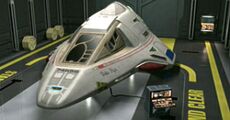
New Atlantic -class runabout
Designed to be the true successor to the modular and highly-useful Danube class runabout, the New Atlantic class runabout is the closest upgrade in terms of size, capabilities, and modularity to her older sister. This class was developed with lessons learned from some of the other runabout classes developed after the Danube but is generally an evolutionary design rather than a revolutionary design; while it uses some novel components, such as annular warp coils, most of her systems are tried-and-true. It is especially popular for long-range missions, as its modules allow it to be equipped with additional fuel and comfortable living quarters.
The ship is slightly longer and taller than the Danube-class, with a cockpit in the nose of the craft on the upper level, followed by crew rest areas, additional crew stations, and small cabins for four. The lower module is especially large and essentially can change this vessel's entire configuration with a single overhaul stop. Configurations for these modules range from passenger modules, to command-and-control modules, to VIP accomodations, to scouting and scientific modules, to tactical modules. In addition, this class has additional mounting points for two modules on the top of the hull, which range from torpedo launchers to phaser cannons, which can turn this ship into a capable gunship for patrols.
In the center of each warp engine are two extendable cylindrical modules which hold two of the craft's phaser arrays, which can rotate to optimize firing solutions. There are also two fixed arrays on the top of the ship.
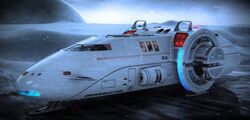
Executive type runabout
The Executive type runabout was classified as a shuttle until the category of runabouts was introduced in the mid-24th century. This class of vessel is used to transport dignitaries and senior officers from ground to orbit in relative comfort. It is also capable of intra-system flights and is relatively common in the core worlds. Unlike purpose-built runabouts, however, they aren't capable of long-distance journeys.
Entry is provided through two side hatches, which also separate the cockpit from the seating area. It has a single large impulse engine on the stern and is equipped with standard navigational shielding, but no weapons.
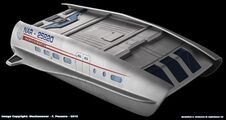
- Specifications
- Federation Small Craft Classes
- Federation Small Craft
- Auxiliary Craft
- The Original Series
- The Animated Series
- The Next Generation
- Deep Space Nine
- Strange New Worlds
- Lower Decks
- Star Trek Movies
- TrekCore on Twitter
- TrekCore on Facebook

All review photos courtesy of IronCaniac.
Ever since I was a kid and saw the first LEGO space themed set, I hoped that there eventually would be a Star Trek theme. Alas, despite LEGO adding licensed sets from many pop culture franchises like Marvel, Disney, and Jurassic World over the years, there was never a Star Trek set. That all finally changed when began selling officially licensed Star Trek sets – and as I’m partial to minifig scale vehicles, the first set I chose to get was their 493-piece Class F shuttlecraft.
It’s been a few years since I’ve built a brick set, but I was able to finish this shuttle in just under three hours. Even though these weren’t LEGOs, the build experience was completely indistinguishable from building with LEGO bricks. The pieces fit together just like LEGOs do, likely because LEGO’s patents have expired and now other companies can make brick pieces exactly to LEGO’s specs.
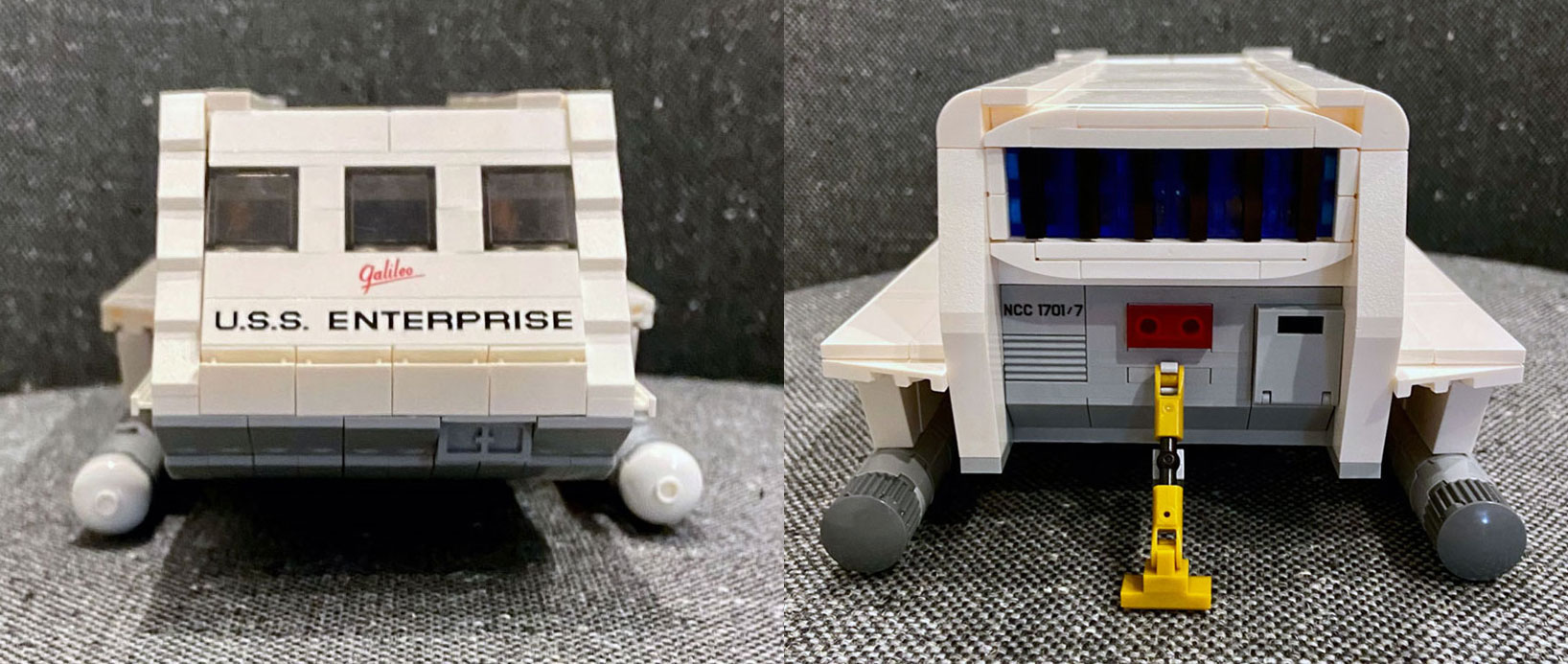
What impresses me the most is just how closely the brick model resembles the onscreen Galileo shuttle from the Original Series. It’s a good thing that shuttle was so blocky in appearance, but it’s also a testament to BlueBrixx’s attention to detail in what they chose to re-create in brick form. The pieces fit together very tightly, making this model very sturdy… except for its nacelles.
The nacelles are the only weak point in the model. As in, literally, they’re a weak point — the front third of the nacelles have a tendency to disconnect if you accidentally put downward pressure on the model’s bow; this is because the shuttle model actually rests its full weight on the nacelles.
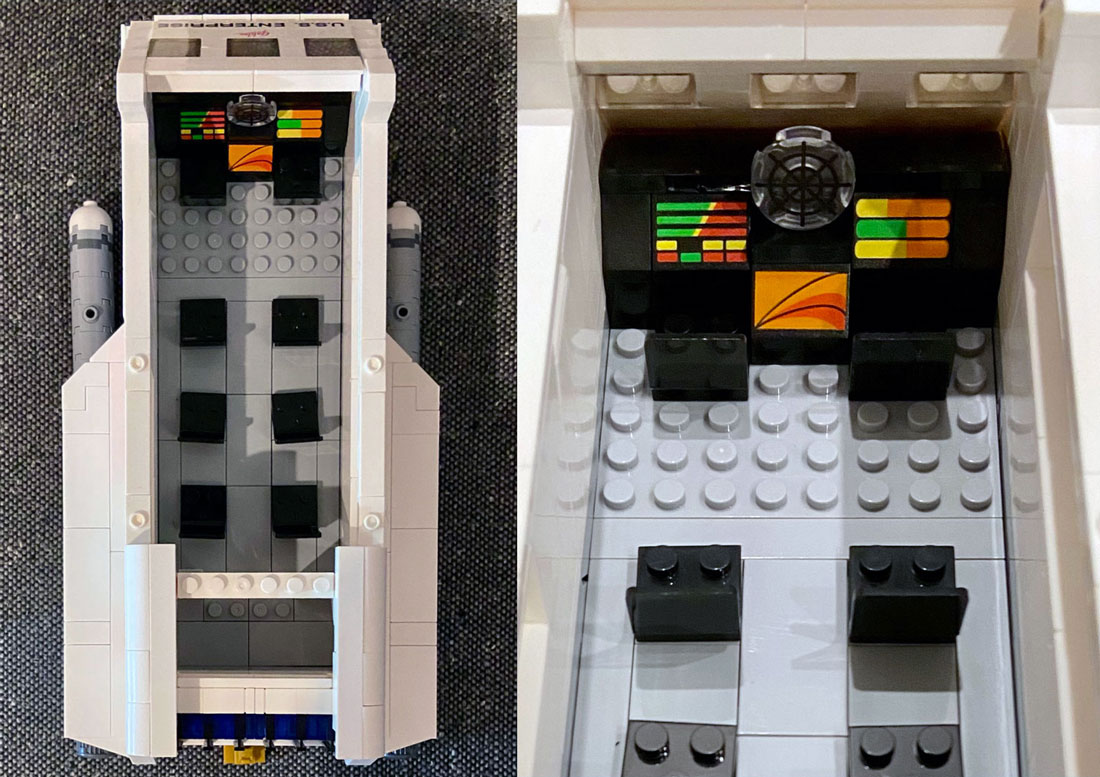
Without anything to support the shuttle’s front half, the nacelles’ front sections bear a lot of strain at the segments that contact the surface. This minor shortcoming doesn’t detract from the model at all, though, because the nacelles hold together surprisingly well, all things considered — as long as you’re careful about where you’re putting pressure. You could also solve the problem by placing something like an extra brick or a small display stand underneath the forward bow to support it.
Being in minifig scale, the model naturally has an interior that can accommodate them. There are no minifigs included with the set, but as with the onscreen shuttle, there are seats for up to 8 figures – plus some standing room behind the helm too. Interestingly, the Memory Alpha entry for the Class F shuttle is officially listed as having a crew complement of only 7, so perhaps the extra seat is intended to be for one of the pilots when then they need a break!

The interior is every bit as detailed as the exterior and accurately replicates what was seen onscreen to the extent that is possible in small plastic bricks. There is also an aft compartment that I don’t believe was ever seen onscreen (and is not accessible from the main compartment unless you remove the door).
That could present an opportunity for creativity: customizing the space using other bricks, which I look forward to trying at some point.
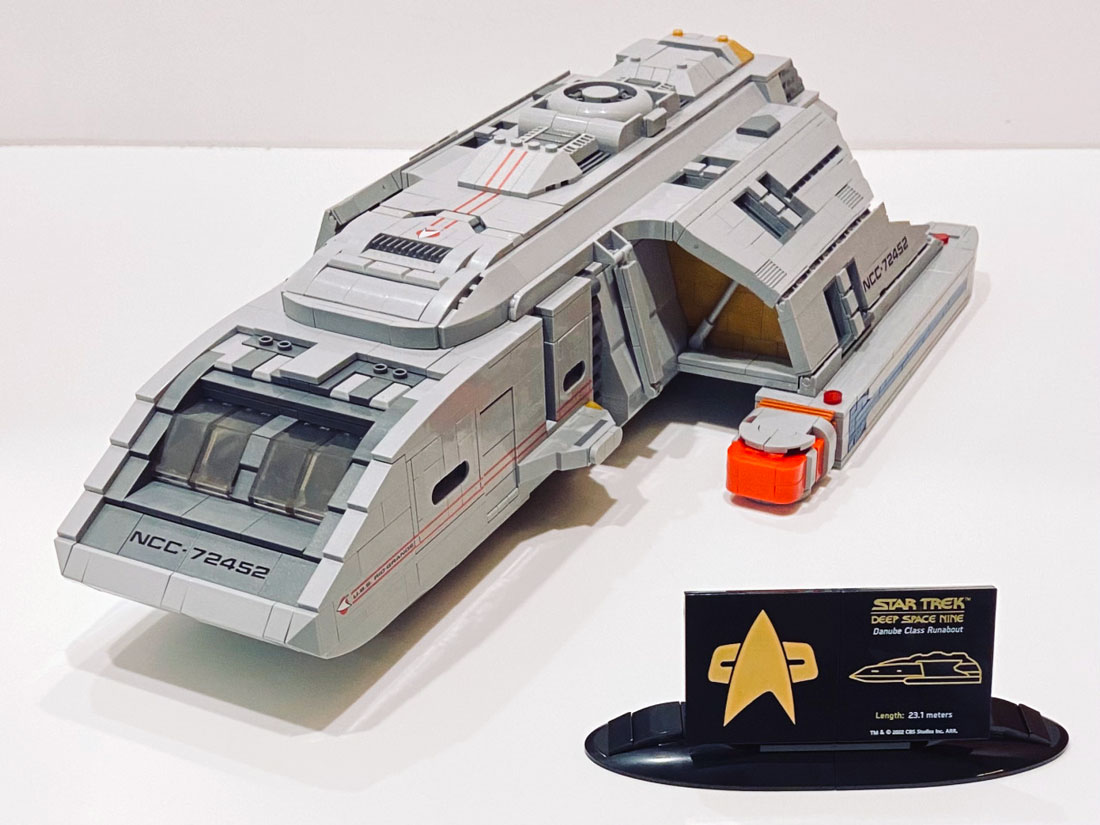
The USS Rio Grande was one of the three original Danube -class runabouts assigned to Deep Space 9. It was the only runabout of the original trio to survive the full run of the Star Trek: Deep Space Nine series. Over the course of the series, the Rio Grande discovered the Bajoran wormhole, crossed over into the Mirror Universe, and even singlehandedly destroyed a Jem’Hadar attack ship.
A vessel with such an illustrious career deserves a tremendous tribute, and BlueBrixx fittingly has made sure that its 3090-piece Rio Grande model lives up to the distinguished runabout.
As with the Galileo shuttle, the most striking initial impression is just how closely this brick-built model resembles the onscreen Rio Grande , both in its exterior and interior. BlueBrixx has recreated just about everything that was depicted onscreen, even the rear sleeping and dining compartment — complete with a replicator! – that wasn’t even seen in Deep Space Nine , but in TNG’s “Timescape.”
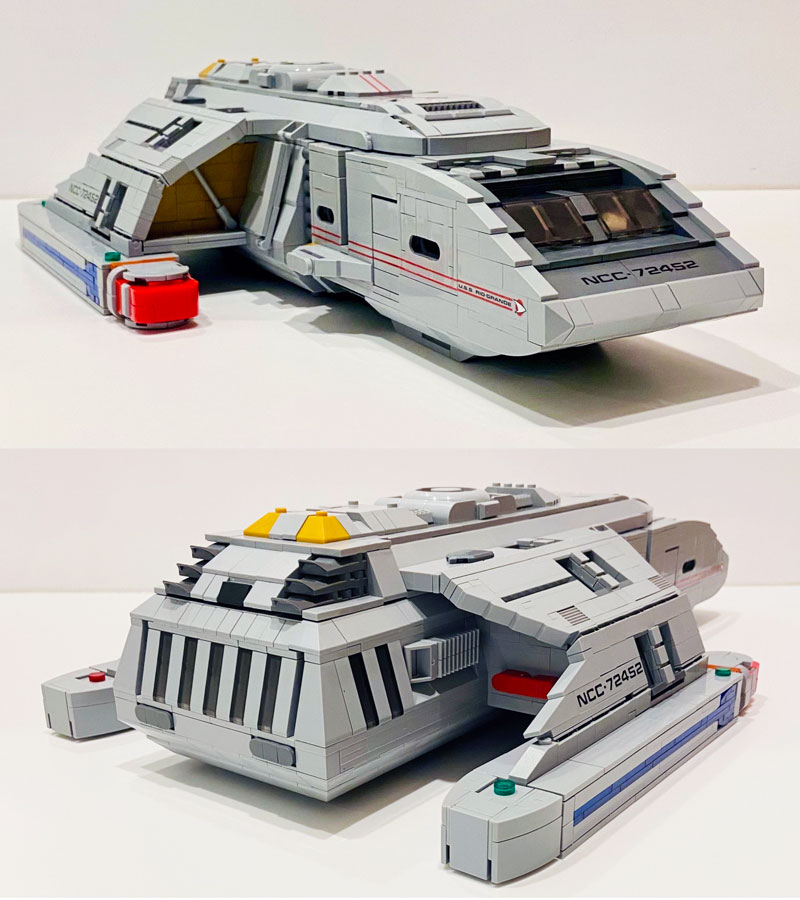
Most impressively, the designers have also included things that were never seen onscreen, such as the specialized mission modules in the midsection and engine components in the pylons.
The build experience on this one is best described as similar to running a marathon; proper planning and pacing is a must. The runabout may look sleek and compact when finished, but this massive set is a beast, and more than likely will take you at least a few days to complete.
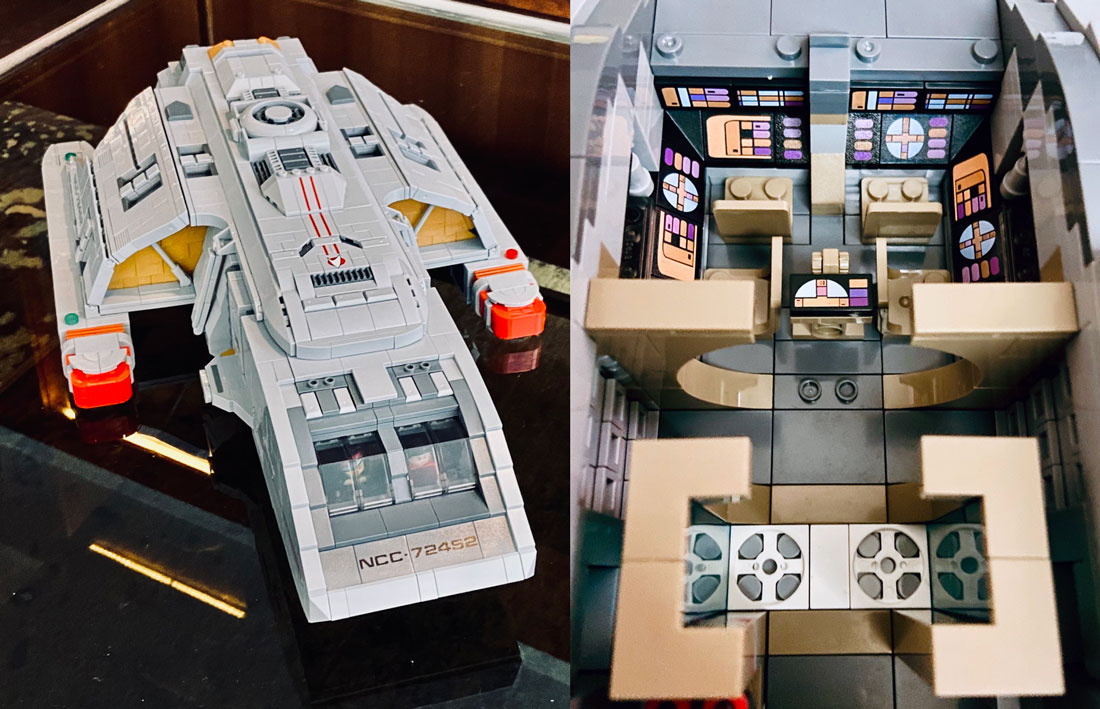
I wouldn’t consider it a set for beginners, and it’s definitely not a set for kids. The build is still a very rewarding experience, especially when you finally snap on the top cover and start to hear the DS9 theme play in your mind. (Well, maybe that’s just me!)
As the BlueBrixx product page shows, the set includes a rollbar that was seen on some runabouts, most notably in “The Jem’Hadar.” I’ve opted not to include this rollbar on my model, because the Rio Grande was only equipped with this module in just one out of its 40 appearances.
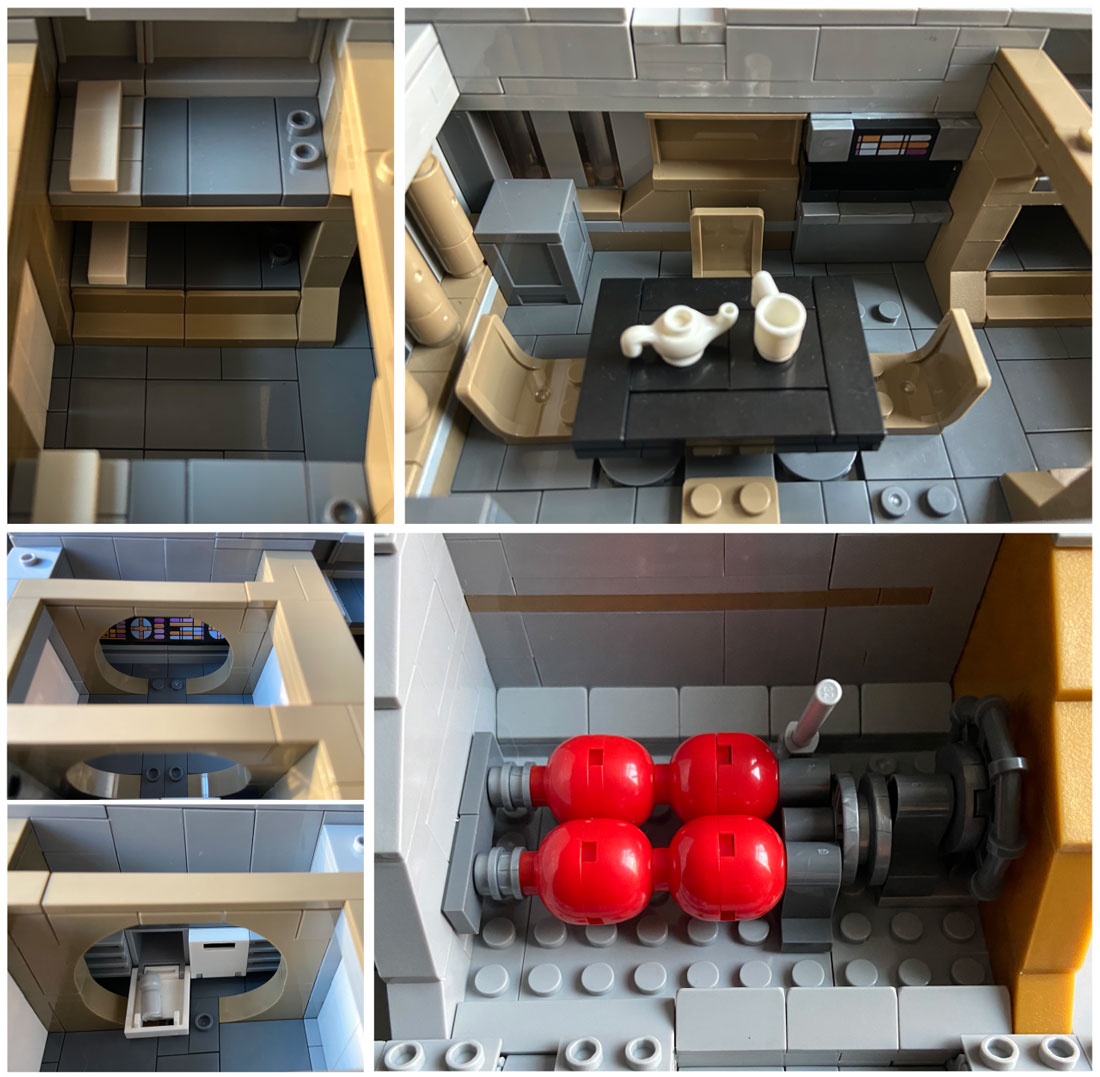
One of the great things for me about brick sets is that you can inject your own creativity as you build. For example, I wasn’t crazy about building the toilet that BlueBrixx included in the instructions, so I used some spare LEGO bricks and custom minifig accessories to create an armory in its place. I think the armory turned out pretty well, and the LEGO bricks fit seamlessly in case anyone was wondering about compatibility.
Now that I’ve built multiple BlueBrixx Star Trek sets, it’s becoming increasingly evident to me is that these kits are clearly a labor of love, developed by devoted Star Trek fans. I’ve noticed many places where the designers could’ve opted for a simpler build but went with a more complex, intricate setup to match more closely the appearance of the onscreen ship as much as possible.
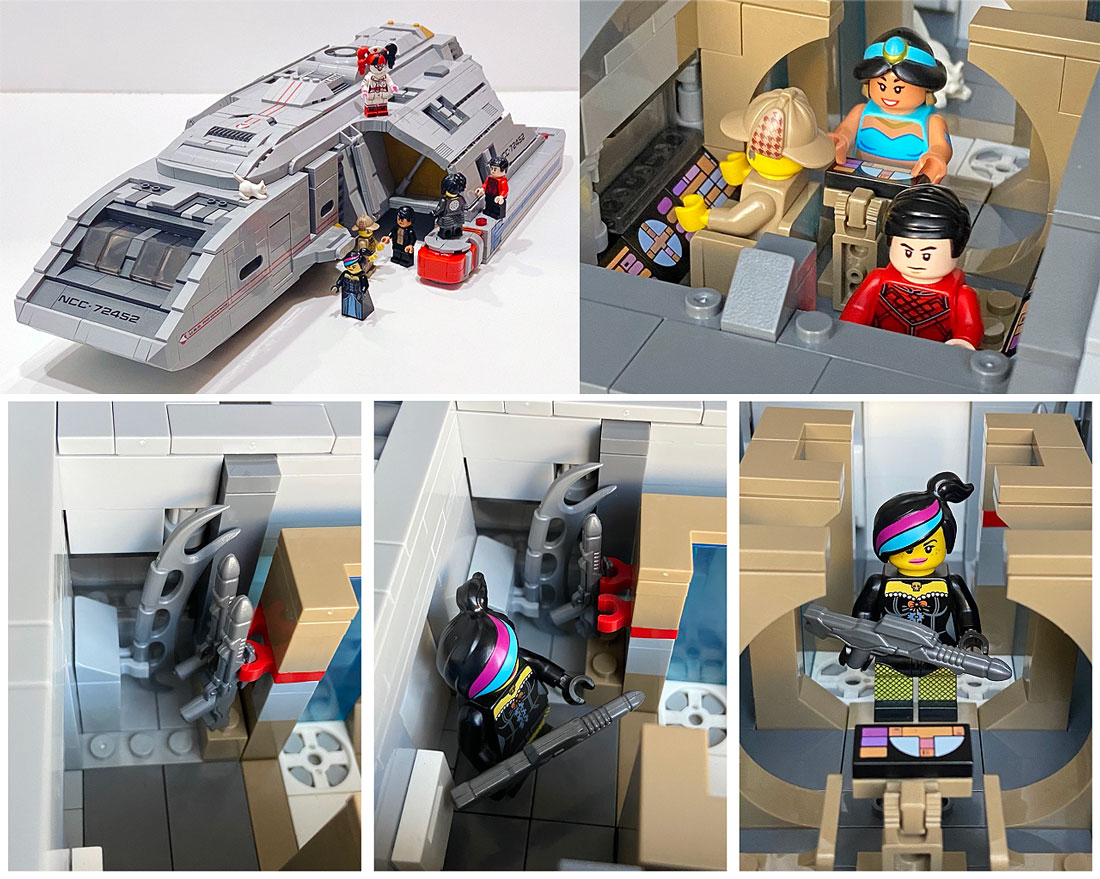
For someone who’s waited a long time for Star Trek themed LEGO sets, it’s such a joy to see Star Trek building brick sets being made by people who really care about paying homage to the franchise and doing their best to recreate some of its icons. I look forward to many more BlueBrixx sets, especially more small craft in minifig scale!
In addition to the new products BlueBrixx announced earlier this summer which are now making their way to collectors’ homes, the company also unveiled a host of new Star Trek builds at the recent Destination Star Trek Germany convention last weekend.
While their convention video is of course presented in their native German language, the new starships and other brick-build designs speak for themselves — expanding the BlueBrixx catalog from the earliest days of warp spaceflight to the far reaches of the Delta Quadrant.
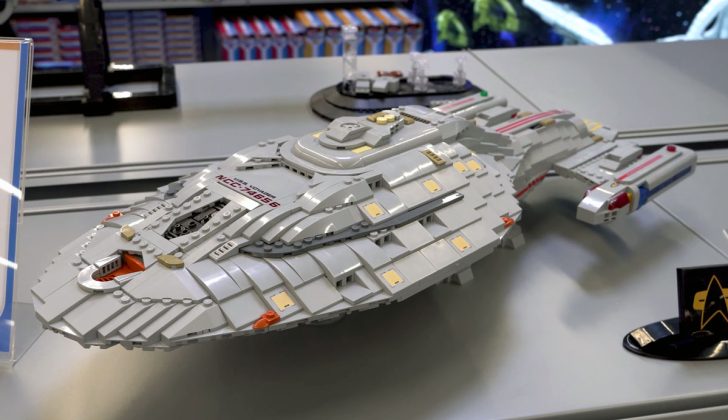
All of BlueBrixx’s available Star Trek build sets are for sale through their website, which ships internationally from their Germany distribution center. (If you’re interested in any of their newly-previewed products, you can sign up to be notified when each becomes available on that page.)
Have you bought any of BlueBrixx’s builds from their first or second wave of Star Trek releases? Do any of the new Wave 3 builds grab your attention? Let us know in the comments below!
- Trek Merchandise
Related Stories
New star trek: discovery photos — “mirrors”, interview — sonequa martin-green on burnham’s “face the strange” encounter, lost-for-decades original star trek uss enterprise model returned to roddenberry family, search news archives, new & upcoming releases, featured stories, star trek: lower decks cancelled; strange new worlds renewed for season 4, our star trek: discovery season 5 spoiler-free review.
TrekCore.com is not endorsed, sponsored or affiliated with Paramount, CBS Studios, or the Star Trek franchise. All Star Trek images, trademarks and logos are owned by CBS Studios Inc. and/or Paramount. All original TrekCore.com content and the WeeklyTrek podcast (c) 2024 Trapezoid Media, LLC. · Terms & Conditions
Geek Native
From the land of Geek
Navigate the Enterprise: 6 Star Trek floor plans
November 20, 2018 by Andrew Girdwood Leave a Comment Links may earn commission
Geek Native has featured marketing efforts from Angie’s List before. They’ve done illustrated architecture which was gorgeous and nostalgic pixel floorplans . I guess geeks make a good audience and there’s some floorplan related service Angie’s List can help with because they’re back for round three .
This time it’s Star Trek.
Want to see inside a Captain’s cabin on the Enterprise or one of the other iconic ships in the Star Trek fleet? Now’s your chance.
Star Trek: The Original Series – James T. Kirk’s Quarters
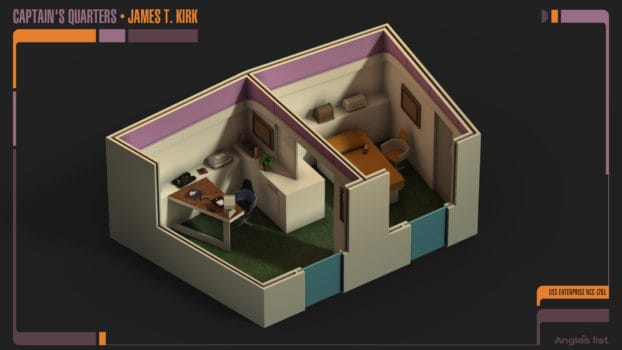
Star Trek: The Next Generation – Jean-Luc Picard’s Quarters

Star Trek: Deep Space Nine – Benjamin Sisko’s Quarters
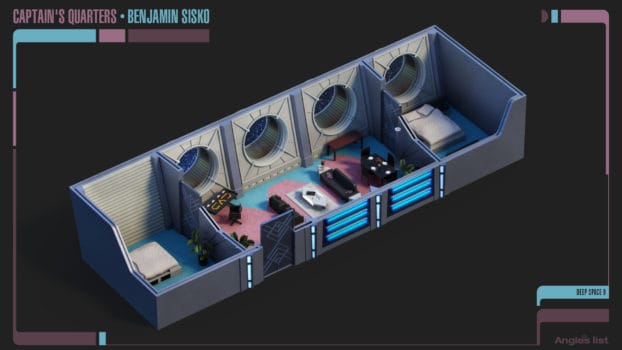
Star Trek: Voyager – Kathryn Janeway’s Quarters
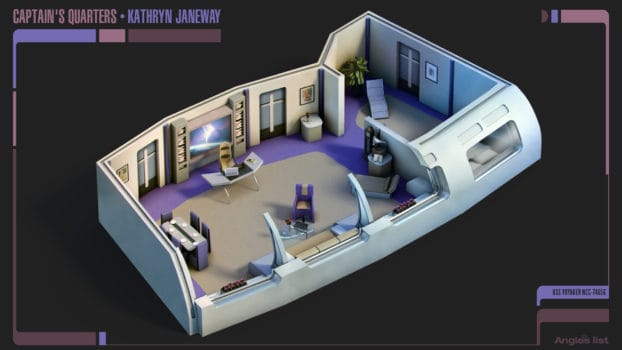
Star Trek: Enterprise – Jonathan Archer’s Quarters
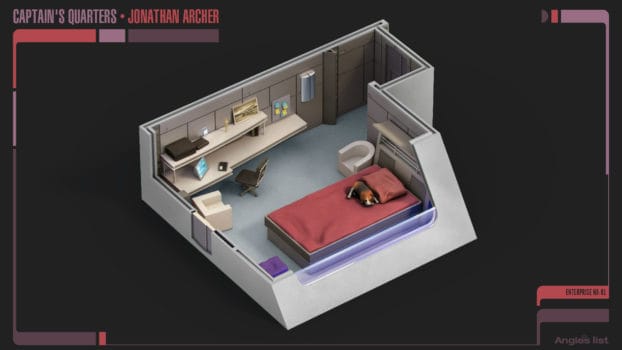
Star Trek: Discovery – Gabriel Lorca’s Quarters
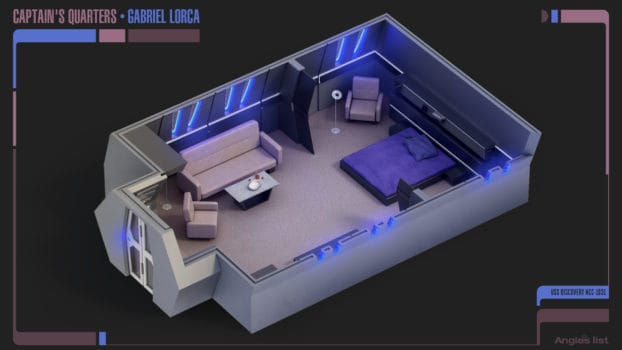
Wait. Does Lorca belong on this list? Does he count?
Join (or start) the healthy debate. Share your observations below.
Explore these posts
- Advertising Disclaimer : As an Amazon Associate I earn from qualifying purchases. Geek Native also earns money through DriveThruRPG and Skimlinks. Find out how .
- Level up your cool by leaving a comment below or following on Pinterest .
This site uses Akismet to reduce spam. Learn how your comment data is processed .
- Corrections
- Quick RPG news summaries
- Quick mini-reviews
- Quick highlights podcast
- Recent Kickstarters
- Competitions!
Recent Posts
- Routinely Itemised: RPGs #253
- D&D’s 2-player Onslaught board game has a cracking sale 50% off
- Fun trailer for indie UFO sci-fi comedy film ‘Foil’
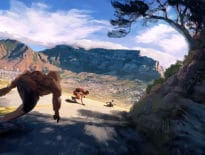
To provide the best experiences, we and our partners use technologies like cookies to store and/or access device information. Consenting to these technologies will allow us and our partners to process personal data such as browsing behavior or unique IDs on this site and show (non-) personalized ads. Not consenting or withdrawing consent, may adversely affect certain features and functions.
Click below to consent to the above or make granular choices. Your choices will be applied to this site only. You can change your settings at any time, including withdrawing your consent, by using the toggles on the Cookie Policy, or by clicking on the manage consent button at the bottom of the screen.
- More to Explore
- Series & Movies
Coming Soon
Blast, that page isn’t here yet. Return to the homepage or try a search .
If you think there should be something here, please reach out for support .

Delta Flyer (2375)
- View history
The Delta Flyer was a specially designed Starfleet shuttlecraft constructed by the crew of the USS Voyager in the Delta Quadrant in 2375 . The vessel was designed to handle environments that would be too hazardous for a standard shuttlecraft and to be slightly larger than the average shuttle, the crew having acknowledged that standard shuttles were of little use in the increasingly hostile and unexplored Delta Quadrant. The vessel was a blend of Starfleet and Borg technology, designed in collaboration between B'Elanna Torres , Tom Paris , Tuvok , Harry Kim , and Seven of Nine . It was conceived as incorporating a tetraburnium alloy hull with ultra-aerodynamic contours, retractable warp nacelles , parametallic hull plating , unimatrix shielding , and a Borg-inspired weapon system, including photonic missiles , most of which were Paris' conceptions. For aesthetic reasons, Paris designed some of the flight controls to resemble those from the holodeck simulation of Captain Proton ; when Tuvok complained, Paris explained that he wanted to feel the ship and that he was tired of tapping panels. But to Paris' disappointment, the addition of dynametric tailfins was denied by Tuvok. Instead of having the usual two pilot stations, it had several command stations. ( VOY : " Extreme Risk ")
Knowledge of this craft was known to Tuvok as early as 2371 but kept secret due to the Temporal Prime Directive . ( VOY : " Fury ")
- 1 Design and first mission
- 2 2375 missions
- 3 2376 missions
- 4 Destruction
- 5.1 Appearances
- 5.2 Additional references
- 5.3 Background information
- 5.4 External links
Design and first mission [ ]
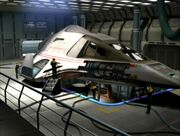
The Delta Flyer being prepared for its first mission
The idea to design a larger, more efficient shuttle than the cramped Class 2 shuttle was first given to the Delta Flyer 's designer, Lieutenant junior grade Tom Paris, by the former Borg drone Seven of Nine in 2375 . ( VOY : " Drone ")
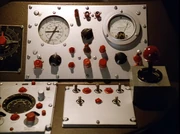
Delta Flyer Analog Cockpit Control Panel
Subsequently, Paris brought up the idea numerous times, but was always rebuffed. Captain Kathryn Janeway finally authorized the craft's construction, which was led by Paris, in order to retrieve a multi-spatial probe that was lost in the atmosphere of a gas giant and in danger of being stolen by the Malon . The deciding factor was that Paris had already laid a lot of groundwork, and so the shuttle would not have to be designed from scratch. The Malon also began work on a shuttlecraft of their own and finished theirs before the Flyer was complete. When the Malon sent out their shuttle, the Flyer was deployed early, despite a flaw in the vessel's structural integrity . The Flyer was successful in retrieving the probe, but a hull breach started to occur. B'Elanna Torres designed a makeshift device that deployed a temporary force field , successfully containing the breach. ( VOY : " Extreme Risk ")
Rejected features included dynametric tailfins . Harry Kim 's repeated calls to reinforce the hull with kellinite were also continuously rejected. ( VOY : " Extreme Risk ")
2375 missions [ ]
The Delta Flyer 's second mission was to infiltrate a Species 8472 terrasphere . Paris, Kim, and Chakotay took the Flyer out to investigate the terrasphere. When the undercover Chakotay was revealed, Voyager rendezvoused with the Delta Flyer . ( VOY : " In the Flesh ")
The Delta Flyer encountered near-destruction in its third mission when it got caught in an ion storm and crash landed three kilometers under rock on a class M planet. Life support began to fail and Paris, Samantha Wildman , and Tuvok did not believe they could be rescued. The Voyager crew was able to dig through the rock and locate the Delta Flyer . The crew and the Flyer were beamed aboard. ( VOY : " Once Upon a Time ")
In early 2375 , Voyager was equipped with a quantum slipstream drive and used it in an attempt to return to the Alpha Quadrant . The Flyer , piloted by Chakotay and Kim, rode the slipstream ahead of Voyager in order to chart the slipstream and send appropriate phase corrections to Voyager . Unfortunately, the drive proved unstable and nearly caused Voyager to lose structural integrity . Fortunately, a Harry Kim from an alternate timeline where the ship had been destroyed, was able to transmit a phase correction directly to Seven of Nine's Borg implants which shut the drive down. Use of the drive was then abandoned until it could be better understood.
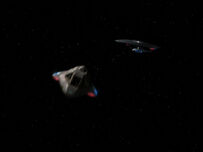
The Delta Flyer being chased by the USS Challenger
In the previously mentioned alternate timeline , the Delta Flyer remained in the slipstream on course to the Federation while Voyager crash-landed on a class L planet . Fifteen years later , Chakotay, Kim, and Tessa Omond stole the Delta Flyer from a shipyard and used it to locate the remains of Voyager . They retrieved Seven of Nine's corpse and The Doctor from the buried ship. By analyzing Seven's cranial implant they intended to determine when it had shut down and thus when Voyager was destroyed, allowing them to transmit their message accordingly. The Doctor was the only person who could determine the necessary temporal coordinates for their mission. They used a temporal transmitter to transmit the proper phase corrections to Seven via the implant, which would allow Voyager to remain safe in the slipstream. Unfortunately, Kim's corrections did not work - but with time running out, The Doctor convinced him to send another message, this time with corrections which would collapse the slipstream. Just as he transmitted the drive shutdown sequence, the Delta Flyer was destroyed by a warp core breach induced by attacks from the USS Challenger . ( VOY : " Timeless ")
A few months later, the Delta Flyer was used to go underwater on The Waters of the Moneans . The Flyer was able to take large amounts of stress, entering great depths of water. It was even able to reach the core of the ocean which was quite deep underwater. This core was actually a large containment field generator. ( VOY : " Thirty Days ")
During a mission where Voyager crew stole a Borg transwarp coil , Seven of Nine was captured by the Borg. The coil was installed on board the Delta Flyer , for which it was used to proceed to the unicomplex to retrieve Seven. When Janeway beamed into the complex, she was stuck there with Seven when the Borg Queen activated a dispersal field . Seven was able to disable the Queen's interface to the collective and the field was deactivated. With Janeway and Seven retrieved, the Flyer proceeded back to transwarp and returned to Voyager , pursued by the Queen's diamond ; they were briefly forced to transfer power from life support to the shields during the pursuit to give themselves the necessary shield strength to reach the exit point before they were captured. ( VOY : " Dark Frontier ")
2376 missions [ ]
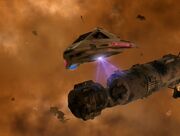
The Delta Flyer tractors the Ares IV inside the ellipse.
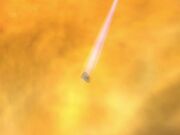
The Delta Flyer is towed out of the ellipse.
When Voyager encountered a graviton ellipse , the Delta Flyer was sent in to locate the Ares IV command module, which was lost in the ellipse in 2032 . The crew of Tom Paris, Chakotay, and Seven of Nine examined several artifacts trapped in the ellipse before finding the command module. While the Flyer attempted to tractor the module out of the ellipse, the ellipse was hit by a dark matter asteroid . The Delta Flyer was severely damaged and Chakotay was injured. Aboard Voyager , B'Elanna Torres devised a method to use an ion distributor from the Ares IV to repair vital components of the Flyer . Seven beamed to the Ares IV module where she located the distributor and downloaded the sensor data and logs of the Ares IV commander, John Kelly . She returned to the Flyer with the distributor and Kelly's body. The distributor was connected to the Flyer power systems and the shuttle was able to escape before the ellipse returned to subspace . ( VOY : " One Small Step ")
During a period of shore leave on Voyager , Janeway took the Flyer to a nearby planet in the Norcadian star system . When Seven and Tuvok were kidnapped by Penk , Voyager engaged in battle with his vessel . Penk was able to disable Voyager , but Janeway arrived in the Flyer and was able to disable Penk's signal antenna, forcing Penk to lower power to his ship's force fields. This allowed Seven and Tuvok, along with several other competitors held hostage aboard the ship, to be rescued. Janeway and the Flyer returned to Voyager . ( VOY : " Tsunkatse ")
Chakotay, Neelix, Harry Kim, and Tom Paris returned from a mission aboard the Delta Flyer and were abducted by a damaged Borg cube run by adolescent Borg. The Flyer was locked in a Borg hangar while the Voyager crew were attempting to negotiate for the return of the shuttle and its crew. Before the Borg cube was destroyed due to a feedback pulse after the Borg attempted to remove Voyager 's deflector dish , the Delta Flyer escaped the ship. ( VOY : " Collective ")
Later that year, Janeway decided to take the Flyer on an astronomical survey, crewed by Voyager crewmembers who were not working to the best of their abilities and who had never been on an away mission. The mission became dire when the Flyer was attacked, disabling its warp drive . Janeway plotted a course for a nearby planet and ordered the crewmen to abandon the Flyer . They refused to leave her, although one crewmember, Mortimer Harren , abandoned the Flyer aboard a escape pod and used it to distract the dark matter object. Harren inadvertently discovered how to deter the object using phasers , which the Delta Flyer used to escape. Soon after Harren was returned to the Flyer , an explosion occurred, disabling it. Voyager picked up the distress signal and retrieved the damaged shuttle. ( VOY : " Good Shepherd ")
The Delta Flyer was impersonated by a vessel piloted by several con artists attempting to use the reputations of the Voyager crew for criminal purposes. In order to track their hiding spot, Voyager captured one of the criminals, Dala , and allowed her to escape aboard the Delta Flyer . Tom Paris and The Doctor stowed away in the aft compartment, apprehended Dala, and retook the Flyer after she flew it to the criminals' hiding spot. ( VOY : " Live Fast and Prosper ")
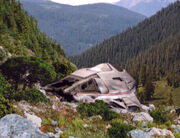
The Delta Flyer , crashed on Kelis' homeworld
While on an exploration mission, the Delta Flyer crashed on a planet with a pre-warp society. Harry Kim was able to evacuate, but B'Elanna Torres remained aboard and survived the impact. A poet on the planet named Kelis found the Flyer and figured out how to access its database, using Voyager 's experiences in the Delta Quadrant as a basis for his plays. Torres attempted to repair the Flyer with Kelis' help, but the ship was damaged beyond her means. Kim eventually located the Flyer and brought an emergency transmitter from the escape pod, which was used to send a distress signal to Voyager . The Flyer was transported aboard and required major repairs. ( VOY : " Muse ")
When Kes traveled back in time to the first year of Voyager 's journey, the tachyon particles caused by her presence in the past resulted in Tuvok experiencing 'flash-forwards' of events that wouldn't happen on Voyager for several years, with the first example of these being when he suggested that the Delta Flyer be used to navigate a region of space filled with subspace vacuoles due to its advanced sensors over four years before it would even be constructed. ( VOY : " Fury ")
Destruction [ ]
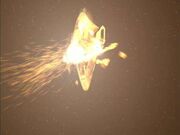
The Delta Flyer is destroyed
In early 2377 , Janeway, Tuvok, and Torres flew the Delta Flyer to a Borg tactical cube , with the goal of infiltrating the vessel and assisting the drones of Unimatrix Zero . While approaching the cube, the Borg Queen located the Flyer . The away team beamed onto the cube just as the Flyer was destroyed. ( VOY : " Unimatrix Zero ")
The destroyed Flyer was replaced by a craft of the same name and of similar design and specification, albeit with fewer " Captain Proton "-inspired embellishments. ( VOY : " Drive ")
Appendices [ ]
Appearances [ ].
- " Extreme Risk " (Season Five)
- " In the Flesh "
- " Once Upon a Time "
- " Timeless "
- " Thirty Days "
- " Dark Frontier "
- " Riddles " (Season Six)
- " One Small Step "
- " The Voyager Conspiracy "
- " Memorial "
- " Tsunkatse "
- " Collective "
- " Good Shepherd "
- " Live Fast and Prosper "
- " Unimatrix Zero "
Additional references [ ]
- " The Disease "
- " The Haunting of Deck Twelve "
Background information [ ]
From the Star Trek Encyclopedia (4th ed., vol. 1, p. 200), " The Delta Flyer was designed by series production designer Richard James and senior illustrator Rick Sternbach . "
Two schematic lots from production designer Richard James of the Delta Flyer 's interior were sold off on the It's A Wrap! sale and auction on eBay. [1] [2]
External links [ ]
- Delta Flyer at StarTrek.com
- Delta Flyer at Memory Beta , the wiki for licensed Star Trek works
- Flyer class at Memory Beta , the wiki for licensed Star Trek works
- Delta Flyer at Wikipedia
Deck plans for STA
Wanted to get a discussion going about deck plans for STA for research purposes. Do you use them, do you need them, how would you use them if you had them?
I don’t mean deck tiles or map tiles, but rather deck plans ( something like this ) showing the interior layout of ships, maybe a master systems display ( something like this ) showing the decks from the side rather than top-down.
STA is largely the first Star Trek RPG where Gamemasters and Players have the internet, passionate fans, and modern art tools at their disposal, and I know there are a lot of great fanmade deck plans, MSDs, and related artwork out there.
What are your favorites? What are your go-to websites for Star Trek deck plans, MSDs, ship art, references, etc.?
What’s your wish list, specifically related to deck plans and the like? Bonus if you can directly relate your wish list to a need within the context of a roleplaying game session or adventure.
Thanks in advance!
Since I have the old FASA ones, I use those for Constitution and D7. SFB/PrimeDirective has a couple interesting ones that I’ve used… free trader and civilian small freighter. The G1 plans are for a small klingon ship, about runabout sized.
I redrew the SFTM plan segments near my preferred scale
I am not an active, but (hopefully) soon-to-be active STA GM. I do prepare a campaign for my regular group which I intend to GM when we finished my/our current fantasy campaign.
Deck-Plans were virtually the first thing I searched during this preparation. This is the trove I discovered. But, as I see, you did, too.
I will need them, to create a better image of the place where the characters live, where they experience their adventures.
In fantasy games, I have maps of the surroundings to show where the adventures happen. If the party will stay within a lager village, or city, I will provide maps so the players can relate the localities with one another (this is probably bad english; hope you understand). If the party (or one player’s character, for that matter) acquires a fortress or some other holding – right, floor plans, you already got it.
For ‘modern’ games (take Vampire: The Masquerade, which I used to play years ago); or take the well-known Shadowrun franchise, I use actual maps (from e.g. the OpenStreetMap Project) and modify them. Etc.
Most of the time, the maps serve the purpose of showing the progress of exploration. Speaking in terms of the GNS-Model, I am a strong S-type person as I am an N-type person. So, when I DM, there is always a world to explore for my players with unique places and persons to discover. The map adds a new dimension to the game because it can show/tell connections of persons, places and their surroundings; if you see that the castle of Sir Lordlylord Castleowner lies directly adjacent to the Hell-Deep Pits of Fiery doom, it will be instantly clear to you, why he so much despises fire-creatures.
You might think that, translated on STA, this purpose would be served well with starcharts and maps of the galaxy, regions of space or even sectors. This is correct. But it is, in my opinion, not enough.
The deck-plan, in my opinion, is central for the perception of the group’s major NPC, the ship. The ship is, where adventures start and end and very often the whole stage where the play is set. It is the home of the characters and, just like Sir Lordlylord and the Firebeasts, ‘seeing’ how far away from another two places are set (or how close they are on the map), you will add another layer of immersion to the game.
Moreower, with deck plans, at least a MSD, you can actually check on which deck cargo bay 3 is located. I am totally fine with people who can randomly shout “Captain, multiple hull breaches on deck twelve, sections forty to forty-five. We need to shield the flank from the enemy fire!” in the midst of a fire-fight. Even if the game is set on a Defiant-Class ship (remember: three decks). I could not. Knowing and seeing where the things are in ‘physical’ relation to another is part of the immersion I need and enjoy.
This is basically how I would use them. As a narrative tool to set the stage. I’d print them out (I’m a paper person; at least one of my players will require PDF, though) and show them to the players, maybe even use them for stategic or tactical purposes (“Three Klingon boarding teams beam in here, here, and here. With the remaining Security teams abord, you can only engage two. Where will the security teams be sent?”) though this might be, because I now played D&D for longer than I did not in my life.
On whishes, I would like to refer you to the Official Product Whishlist here at this forum. My search for “deck plan” got 19 results.
I use them for ship-centric episodes in which I treat the plans as sort of an internal scan showing the location of whatever interesting thing is front and center - intruders, engineering emergency, and so on. I was happy to find deck plans for an Akira Class vessel, as my home game has my players crewing the USS Damocles during the Dominion War. Please, PLEASE, PLEASE!!! Make deckplans an official part of Star Trek Advnetures.
One remark, since you, @Modiphius-Jim , mentioned internet: When we, our group, play, I as DM most of the time have access to a TV big enough that the whole group can look at it, or even a projector (funny sidenote: these things are called ‘beamer’, pronounced English, in German). I also already used electronic versions of maps and these to make notes on a map or sketch a path etc. This would be another use-case.
For me deck plans are a nice to have but not essential, that said I’d love to see em as part of a supplement (I’d only buy em stand alone if they where electronic document that didn’t cost too much) I’d also like to put some other thoughts, first of all the inital reaction is going to be to do deck plans for the TV show hero ships., but remember there are lots of those already out there, so try not to forget the popular ships that may not have featured in a series, Nebula deckplans for example would be nice. Secondly, more important then just deck plans (which will inevitably not be comprehensive anyway) would be a listing of how many decks a ship has, and whats on there. Also please for god’s sake make the thing “realistic” remember that a ship has a lot of mechanical stuff etc under the bulkheads, don’t just succumb to the temptation to do deck plans that fill in the interior space without at least rememebring machinery in the walls etc. a lotta sci-fi deckplans make that error and as someone whose worked in a shipyard it’s a pet peave
This! I did this for the constitution class for my playtest group. I’m thinking of doing same for the saladin and hermes.
I’d love a consistent set of full plans for the SFTM ships - DN, CA, DD, SC, Tug - and a TOS era version of the Miranda class (sometimes called the Anton class, from FASA)… but with “mission configuration” options. Not unlike how ADB provided mission module replacement plans for their freighters.
deck listing wise BTW I’ve been using this website as a source of info for my games http://techspecs.acalltoduty.com/sitemap.html
Very well spoken. Garrett

they do, although they’re almost universally for the enterprises and other “hero ships” some ones for differant classes could be fun
Not always - there are those for smaller ships too. Here’s one for the Nova class:

Not my work. All credit due to original artists.
ohh those are useful, I’d not found those of EAS
Thanks a lot! Shortly after my initial post in this thread, it occured to me I forgot these. I wanted to add them later and ultimately forgot it.
Thank you for bringing this up! These are indeed very helpful for immersion, imo.
I love those isometric diagrams. There’s a guy on DeviantArt – falke2009 – who has been diagramming a refit of the Nova class. His work is pretty attractive, and he doesn’t just limit his attention to the usual areas (like the bridge and the sickbay) – he gets a bunch of unusual rooms. One of my favourites is his model of the computer core, because it’s a space we never really see in the show.

I like his style so much, I’ve been playing with a similar aesthetic:

3D models like these are pretty easy to make for someone with experience. And they do wonders for being able to visualize ship areas.
I like the isometric ones too. I just wish they had no characters so I could use them for battle maps more immersively.
I would use deckplans similarly to what others have posted, mainly for immersion. I also really love the idea of some illustrations included.
Also agree that some of the designs not featured in TV or other media would be the biggest impact. What does a Steamrunner feel like? Does it typically have a holodeck? Etc.
I also like to use these as aids for developing plot beats. “You can’t repair the engines from here on the bridge, you need to get to engineering. There’s a hull breach on deck 5, so you can’t go the direct route. The unidentified vessel is coming about for another pass. What do you do?”
Do they spend power to transport? Take the long route? Don suits? Etc.
Clearly I can do this without, but it’s a nice aid to get me thinking, and gold to illustrate to players.
Generic curved corridors, modular bridge consoles that can be fitted together in any order, standard room templates with furniture you can add (tables, chairs, bunks, consoles, screens etc). Dungeons and Dragons has been using this floorplan format for 40 years. You would just need different sets for different species.
To be totally honest: No, I don’t think they are needed, there is enough Material out there. But as I know myself, I would propably buy it anyway.
Related Topics

IMAGES
VIDEO
COMMENTS
Variations of the Runabout Interior. by Jörg Hillebrand and Bernd Schneider. Season 1 Season 2 Season 3 Season 4 Season 5 Season 6 Insurrection Season 7 Summary. The Danube-class runabout first appeared in DS9: "Emissary". Over the years, its cockpit was remodeled several times, most notably between the 4th and the 5th season of DS9.
Star Trek: The Motion Picture Official Blueprints. U.S.S Enterprise NCC-1701A Deck Plans. USS Enterprise Schematics (Kelvin Timeline) USS Enterprise Color Schematics. (Kelvin Timeline) U.S.S. Enterprise NCC-1701. Uprating and Revision of Basic Design.
In Federation starship classification, a runabout was the designation of a type of vessel smaller than a starship but larger than a shuttlecraft. Runabouts were equipped with limited weapons and drive systems, but offered additional living space and the ability to be configured to mission-specific cargo capacities. They had a larger operational range and better weapons capability compared to ...
First off, you need to segment the Runabout into 5 basic sections: the Flight Deck, Transporter Area, Power Distribution Bay, Living/Sick Bay, and Conference Room. Inset a piece of sheet styrene to fit the interior ceiling from front to rear. Also, do the same to create a floor in the lower half of the hull.
This is the story of a little ship that took a little trip: DS9's runabout.Read the article here: https://whatculture.com/tv/star-trek-10-secrets-of-the-danu...
The USS Rio Grande (NCC-72452) was a 24th century Federation Danube-class runabout operated by Starfleet. This ship was assigned to Deep Space 9. The Rio Grande was one of the three runabouts offloaded at DS9 by the USS Enterprise-D. The Rio Grande was the first vessel to discover the Bajoran wormhole in 2369, and was the only Starfleet runabout to remain operational at Deep Space 9 for the ...
After over a year of work, the Runabout Project is finally here - blueprints for the cockpit as it first appeared in the DS9 pilot episode. These plans should be of help to anyone who wants to build their own Runabout cockpit in cg or as a physical build. I think the set is ideal for fan films, and if anyone builds a set from these plans, I ...
These plans are of the Runabout set as it first appeared in the pilot episode of DS9. The plans aim to help others build their own set, whether it be physical or cg. ... Cygnus-X1.Net: A Tribute to Star Trek is maintained by John Patuto. "Cygnus-X1.Net" is in no way associated with, nor endorsed by, Paramount Pictures and/or Viacom; Pocket ...
Gerard Gillan of the famed Gilso's Star Trek Schematics Site has graciously granted permission to the Star Trek LCARS Blueprints Database to host a sampling of his superbly illustrated schematics. Please make sure you visit Gerard's site for more schematics from both the Star Trek and Star Wars universes. While you may find Delmar fans and ...
Introduced in the Star Trek: Deep Space Nine pilot episode "Emissary," as the station's primary support craft, the Danube-class runabout has joined now joined the ranks of Eaglemoss/Hero Collector's line of XL Starship models.. Designed to be more durable and versatile craft than the shuttles that preceded them, the runabout was originally designed by Rick Sternbach and Jim Martin ...
The Danube-class, also known as Runabout-class, was a type of Federation runabout in operation during the latter half of the 24th century. All runabouts assigned to Deep Space 9 were named after rivers on Earth. (DS9: "Family Business") The Danube-class was first commissioned by Starfleet in 2368 as a small, short-range interstellar craft. (DS9: "Paradise") The following year, the space ...
The Danube class runabout was initially the way characters in Star Trek: Deep Space Nine got around before they acquired the USS Defiant at the beginning of Season 3. It continued to be featured heavily for the rest of the season, even taking on the title role in the episode One Little Ship. Unlike most spaceships in TV and the movies, the runabout was designed at the same time the sets were ...
Beefed-up runabout. Yet it was the runabout concept artist Jim Martin initially "beefed up." "I started with the cockpit windows," he recalled in an interview with Star Trek: The Magazine, "and worked my way out, adding things on top of the runabout, making it look like they were adding systems and weapons to an existing ship."
When I was a kid I had this really cool book that had all these detailed schematics and floor plans and stuff for the Enterprise A, I think. Did they ever do these for the TNG/DS9 era vessels? Does anyone have them? I was thinking about the Runabout in particular.
Developed in the late 2380s, the Arrow class runabout is a much larger craft than the Danube class runabout, at around twice its length. It is intended for longer duration missions and can support larger crews. Unlike its smaller cousin, it is less modular; interior spaces can be reconfigured for mission needs, but it is more complicated than simply swapping different modules, so typically ...
Germany brick-build set company BlueBrixx made their way into the Star Trek universe in late 2020, and their second wave of products caught fans interest this summer with giant construction kits for the Deep Space 9 space station, a full-sized Starfleet phaser rifle, and more. These kits, both small and large, have been making their way to fans worldwide (as the company is only licensed to ...
The design was inspired by a Maquis fighter that Martin had previously designed for Deep Space Nine and bears resemblance to a small Cardassian vessel, later known as the Hideki class, that Sternbach designed for the season-two episode, "Profit and Loss.". Zimmerman's request for something unique was certainly met: the Defiant was the first Starfleet vessel without external warp nacelles.
Navigate the Enterprise: 6 Star Trek floor plans. November 20, 2018 by Andrew Girdwood Leave a Comment Links may earn commission. Geek Native has featured marketing efforts from Angie's List before. They've done illustrated architecture which was gorgeous and nostalgic pixel floorplans. I guess geeks make a good audience and there's some ...
The Star Trek Blueprints (or Booklet of General Plans) are a detailed "Complete Set of 12 Authentic Blueprints" (sized 9 × 30 inches) of the USS Constitution (NCC-1700), a ship of the same class as the USS Enterprise (NCC-1701). (The cover claims the blueprints are "of the Fabulous Starship Enterprise".) The reader is warned in the General Notes that begin with Sheet 4 that the "Booklet Of ...
If you think there should be something here, please reach out for support.
By. samuelkowal906. Watch. Published: Jan 26, 2008. 54 Favourites. 2 Comments. 14.2K Views. This is a floor plan of Deck 2 of the USS Raven, the ship commanded by the Hansens who were sent out to study the Borg. This was done at the request of for a novel he is writing about the Hansens' adventures.
The Delta Flyer was a specially designed Starfleet shuttlecraft constructed by the crew of the USS Voyager in the Delta Quadrant in 2375. The vessel was designed to handle environments that would be too hazardous for a standard shuttlecraft and to be slightly larger than the average shuttle, the crew having acknowledged that standard shuttles were of little use in the increasingly hostile and ...
STA is largely the first Star Trek RPG where Gamemasters and Players have the internet, passionate fans, and modern art tools at their disposal, and I know there are a lot of great fanmade deck plans, MSDs, and related artwork out there. ... The G1 plans are for a small klingon ship, about runabout sized. I redrew the SFTM plan segments near my ...